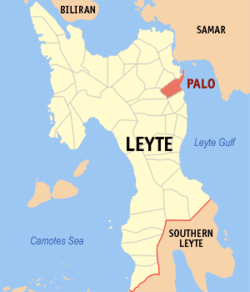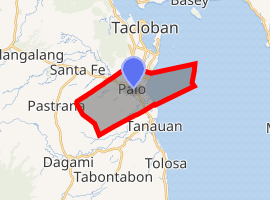Palo, Leyte
Palo, officially the Municipality of Palo, is a 3rd class municipality in the province of Leyte, Philippines. According to the 2015 census, it has a population of 70,052 people.[3]
Palo | |
|---|---|
| Municipality of Palo | |
Palo Cathedral | |
 Seal | |
 Map of Leyte with Palo highlighted | |

| |
.svg.png) Palo Location within the Philippines | |
| Coordinates: 11°09′30″N 124°59′30″E | |
| Country | |
| Region | Eastern Visayas (Region VIII) |
| Province | Leyte |
| District | 1st District of Leyte |
| Founded | 1768 |
| Barangays | 33 (see Barangays) |
| Government | |
| • Type | Sangguniang Bayan |
| • Mayor | Frances Ann B. Petilla |
| • Vice Mayor | Ronnan Christian M. Reposar |
| • Congressman | Ferdinand Martin G. Romualdez |
| • Municipal Council | Councilors
|
| • Electorate | 42,949 voters (2019) |
| Area | |
| • Total | 221.27 km2 (85.43 sq mi) |
| Elevation | 8.9 m (29.2 ft) |
| Population (2015 census)[3] | |
| • Total | 70,052 |
| • Density | 320/km2 (820/sq mi) |
| • Households | 15,584 |
| Economy | |
| • Income class | 3rd municipal income class |
| • Poverty incidence | 22.43% (2015)[4] |
| • Revenue (₱) | 157,879,521.15 (2016) |
| Time zone | UTC+8 (PST) |
| ZIP code | 6501 |
| PSGC | |
| IDD : area code | +63 (0)53 |
| Climate type | tropical rainforest climate |
| Native languages | Waray Tagalog |
| Website | www |
The municipality is the seat of most government departments, bureaus and regional offices of Region VIII, although some are situated at the neighboring city of Tacloban. The town is also home to the offices of the ecclesiastical government of the Archdiocese of Palo; the archbishop's residence; as well as the secondary, tertiary and theology seminaries of the archdiocese.
Geography
The municipality is located in the north-eastern part of the province of Leyte, 8 miles from the capital city of Tacloban.
Barangays
Palo is politically subdivided into 33 barangays. [2]
- Anahaway
- Arado
- Baras
- Barayong
- Cabarasan Daku
- Cabarasan Guti
- Campetic
- Candahug
- Cangumbang
- Canhidoc
- Capirawan
- Castilla
- Cogon
- San Joaquin
- Gacao
- Guindapunan
- Libertad
- Naga-naga
- Pawing
- Buri (Poblacion barangay)
- Cavite East (Pob. barangay)
- Cavite West (Poblacion)
- Luntad (Poblacion)
- Santa Cruz (Poblacion)
- Salvacion
- San Agustin
- San Antonio
- San Isidro
- San Jose
- St. Michael (Poblacion)
- Tacuranga
- Teraza
- San Fernando
Climate
| Climate data for Palo, Leyte | |||||||||||||
|---|---|---|---|---|---|---|---|---|---|---|---|---|---|
| Month | Jan | Feb | Mar | Apr | May | Jun | Jul | Aug | Sep | Oct | Nov | Dec | Year |
| Average high °C (°F) | 28 (82) |
28 (82) |
29 (84) |
30 (86) |
30 (86) |
30 (86) |
29 (84) |
30 (86) |
30 (86) |
29 (84) |
29 (84) |
28 (82) |
29 (84) |
| Average low °C (°F) | 22 (72) |
22 (72) |
22 (72) |
23 (73) |
24 (75) |
24 (75) |
24 (75) |
24 (75) |
24 (75) |
24 (75) |
23 (73) |
23 (73) |
23 (74) |
| Average precipitation mm (inches) | 90 (3.5) |
67 (2.6) |
82 (3.2) |
70 (2.8) |
97 (3.8) |
145 (5.7) |
142 (5.6) |
127 (5.0) |
132 (5.2) |
152 (6.0) |
169 (6.7) |
144 (5.7) |
1,417 (55.8) |
| Average rainy days | 17.0 | 13.5 | 16.0 | 16.5 | 20.6 | 24.3 | 26.0 | 25.4 | 25.2 | 26.4 | 23.0 | 21.0 | 254.9 |
| Source: Meteoblue [5] | |||||||||||||
History
Palo is well known as the site of Gen. Douglas MacArthur's return to the Philippines together with Philippine and American military forces after a period of exile in 1944.[6][7] Hill 522, a hill located near the town center, was the site of fierce fighting between Allied and Japanese forces during the Second World War. The metropolitan cathedral of the archdiocese, located right across Palo's municipal hall, was used as a hospital for wounded Filipino and American forces. A memorial now stands at the beach site where MacArthur and his troops landed, locally known as the MacArthur's Park. The first Gabaldon Building is also situated in Barangay San Joaquin Palo, Leyte. It was inaugurated by President Sergio Osmeña.
Palo was also once the capital of Leyte. The town's Purissima Bridge was the first steel bridge built in the province.
In 1957, sitio Campitic was converted into a barrio,[8] while barrio Baras-Candahug was divided into two: Baras and Candahug.[9] Barrio Malirong was renamed as Libertad.[10]
On November 8, 2013, Palo was severely struck by Typhoon Haiyan (Yolanda), which destroyed a large portion of Eastern Visayas and killed a number of residents in the town.[11] On January 17, 2015, Pope Francis visited the town as part of his papal visit to the Philippines to meet with the surviving victims of the typhoon. He also blessed the Pope Francis Center for the Poor and met with priests, seminarians, other religious figures, and surviving victims of the typhoon at the Palo Cathedral before leaving Leyte.[12]
Demographics
| Population census of Palo | |||||||||||||||||||||||||||||||||||||||||||||||||
|---|---|---|---|---|---|---|---|---|---|---|---|---|---|---|---|---|---|---|---|---|---|---|---|---|---|---|---|---|---|---|---|---|---|---|---|---|---|---|---|---|---|---|---|---|---|---|---|---|---|
|
| ||||||||||||||||||||||||||||||||||||||||||||||||
| Source: Philippine Statistics Authority [3][13][14][15] | |||||||||||||||||||||||||||||||||||||||||||||||||
In the 2015 census, the population of Palo, Leyte, was 70,052 people,[3] with a density of 320 inhabitants per square kilometre or 830 inhabitants per square mile.
Literacy rate in Palo is 99.5%.
The town's native language is Waray-Waray, the major language and lingua franca in the Eastern Visayas region.
Religion
Palo is the seat of the ecclesiastical province, the Archdiocese, where the Roman Catholic Archbishop resides in Bukid Tabor. One can find the Metropolitan Cathedral in Palo. Also, the seedbed of vocations to the priesthood is found at the Sacred Heart Seminary and the St. John the Evangelist School of Theology. Two Paloan nuns were also Superior Generals in their respective congregations. To date, there are 79 ordained priests and 106 nuns from the town alone.
Economy
Palo is the seat of the 6.8-hectare Leyte Information and Communications Technology (ICT) Park and the 22-hectare Leyte Mikyu Economic Zone.[16] The Leyte ICT Park hosts two BPOs while the Leyte Mikyu Ecozone is undergoing development.
The town's historic Municipal Building was the former Seat of the Provincial Government of Leyte.
Agriculture is the dominant industry. The area produced and ferments the local coconut wine "tuba".[17][18]
Tourist attractions

- MacArthur Landing Memorial National Park
- Guinhangdan Hill, a destination of Holy Week pilgrims. The hill is now a forest reserve.
- Japanese Shrine in Barangay Caloogan
- Red Beach - The landmark that has brought Palo to the annals of world history is the Red Beach, in barangay Candahug, where Gen. Douglas MacArthur first landed to liberate the Philippines from the Japanese occupation on October 20, 1944.[6]
- WW2 Memorial for the Filipino Soldiers
- Palo Metropolitan Cathedral
- Palo Binangalan coral reefs
- Palo Mangrove Reservation (open season for duck hunting whole year round)
- Palo Municipal Library and Heritage Museum
- Korean Park
Educational institutions
Private
- Saint Paul School of Professional Studies
- Sacred Heart Seminary
- St. John The Evangelist School of Theology
- Palo Angelicum
- St. Mary's Academy Of Palo
- St Agustine College of Practical Nursing
- Bethel International School
- Zion Bible College
- AMA Computer College
- ELA English Language Academy
- Alpha-Omega Learning Center
Public
{{Columns-list|colwidth=27em|
- UP Manila School of Health Sciences
- Philippine Science High School - Eastern Visayas Campus
- Palo National High School
- Palo Central School (Regular)
- Palo Central School (SPED)
- San Joaquin Central School
- San Joaquin National High School
- Libertad Elementary School
- Anahaway National High School
- Kauswagan National High School
- Luntad Elementary School
- Naga-Naga Elementary School
- Arado Elementary School
- Pawing Elementary School
- Guindapunan Elementary School
- Baras Elementary School
- Canhidoc Elementary School
- Palo National High School- Pawing Annex
- San Antonio Elementary School
- Cogon Elementary School
- Salvacion Elementary School
- San Fernando Elementary School
- Candahug Elementary School
- CAMPETIC ELEMENTARY SCHOOL
Notable people
- Francisco Alvarado - Waray-language poet and playwright[19]
References
- "Municipality". Quezon City, Philippines: Department of the Interior and Local Government. Retrieved 31 May 2013.
- "Province: Leyte". PSGC Interactive. Quezon City, Philippines: Philippine Statistics Authority. Retrieved 12 November 2016.
- Census of Population (2015). "Region VIII (Eastern Visayas)". Total Population by Province, City, Municipality and Barangay. PSA. Retrieved 20 June 2016.
- "PSA releases the 2015 Municipal and City Level Poverty Estimates". Quezon City, Philippines. Retrieved 12 October 2019.
- "Palo: Average Temperatures and Rainfall". Meteoblue. Retrieved 29 February 2020.
- "Leyte Landing". Official Gazette of the Republic of the Philippines. Retrieved 25 January 2015.
- Misagal, Monch Mikko E. (16 October 2014). "Did MacArthur land on Leyte before Oct. 20, 1944?". Manila Bulletin. Retrieved 25 January 2015.
- "R.A. No. 1722: An Act Converting the Sitio of Campitic in the Municipality of Palo, Province of Leyte, into a Barrio to Be Known As the Barrio of Campitic". LawPH.com. Retrieved 2011-04-12.
- "R.A. No. 1723: An Act Creating the Barrios of Baras and Candahug in the Municipality of Palo, Province of Leyte". LawPH.com. Retrieved 2011-04-12.
- "R.A. No. 1740: An Act Changing the Name of the Barrio of Malirong, Municipality of Palo, Province of Leyte, to Libertad". LawPH.com. Retrieved 2011-04-12.
- "Five years later: How 'Yolanda'-hit areas look now". The Philippine Star. November 8, 2018.
- "Pope Francis arrives in Leyte to console Yolanda victims". Rappler. 17 January 2015. Retrieved 17 January 2015.
- Census of Population and Housing (2010). "Region VIII (Eastern Visayas)". Total Population by Province, City, Municipality and Barangay. NSO. Retrieved 29 June 2016.
- Censuses of Population (1903–2007). "Region VIII (Eastern Visayas)". Table 1. Population Enumerated in Various Censuses by Province/Highly Urbanized City: 1903 to 2007. NSO.
- "Province of Leyte". Municipality Population Data. Local Water Utilities Administration Research Division. Retrieved 17 December 2016.
- http://peza.gov.ph Archived 28 March 2013 at the Wayback Machine
- "DOST Eyes Palo, Leyte as Country's Coco Wine Capital". Interaksyon.com. Philippines News Agency. 1 July 2013. Retrieved 25 January 2015.
- "Boosting Philippines' Coconut Wine Industry". Tempo. 20 July 2013. Archived from the original on 25 January 2015. Retrieved 25 January 2015.
- Sugbo, Victor, ed. (1995). Tinipigan: An Anthology of Waray Literature. Manila, Philippines: National Commission for Culture and the Arts. p. 270. OCLC 645852700. Retrieved 27 September 2019.
External links
| Wikimedia Commons has media related to Palo, Leyte. |
| Wikivoyage has a travel guide for Palo, Leyte. |